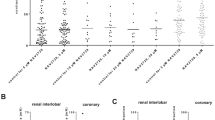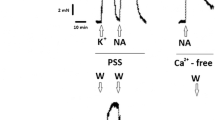Summary
This study was designed to examine the effects of an adenylate cyclase activator, NKH477, on epicardial and endocardial contraction and coronary blood flow (CoF) in the presence or absence of ischemia and to compare it to those of adenosine. We measured coronary pressures (CoP), coronary blood flow, epicardial and endocardial wall thickening (i.e., %EPWT and %ENWT, respectively, by sonomicrometry) in 18 anesthetized dogs. The left circumflex coronary artery was perfused with arterial blood using a pressure controlled servo pump. Propranolol (0.5 mg/kg) and atropine (0.25 mg) were used to minimize the neurogenic effects. CoP decreased from 100 mm Hg to 40 mm Hg with and without drugs. At CoP of 100 mm Hg, intracoronary infusion of NKH477 (10−8 M/kg/min) produced a two-fold increase in CoF, but there were no changes in either the %EPWT or the %ENWT. During coronary hypofusion at coronary pressures equal to 40 mm Hg, NKH477 increased CoF from 16±2 to 28±4 mL/min (p<0.05) and improved %ENWT significantly from 6±7 to 23±7% (p<0.05). However %EPWT was not improved by NKH477. On the other hand, the intracoronary infusion of adenosine (10 μg/kg/min) increased CoF from 16±5 to 21±6 mL/min (p<0.05) at CoP of 40 mm Hg. However, this dose of adenosine failed to improve %ENWT (16±10% vs. 14±10%, n.s.). Thus, the improvement of subendocardial function by NKH477 might be related to the improvement of subendocardial perfusion which could be induced by the potentiation of endogenously released adenosine as well as the direct vasodilator effect. This contrasts with the effects of exogenously administered adenosine, which failed to improve subendocardial contractility.
Similar content being viewed by others
References
Aversano T, Becker LC (1985) Persistence of coronary vasodilator reserve despite functionally significant flow reduction. Am J Physiol 248:H403-H411
Berne RM, Rall TW, Rubio R (1982) Regulatory function of adenosine. In: Martinus Nijhoff Publishers, Boston, pp 19–45
Bristow MR, Ginsburg R, Strosberg A, Montgomery W, Minobe W (1984) Pharmacology and inotropic potential of forskolin in the human heart. J Clin Invest 74: 212–223
Canty JM, Klocke FJ (1985) Reduced regional myocardial perfusion in the presence of pharmacologic vasodilator reserve. Circulation 71:370–377
Cassis LA, Loeb AL, Peach MJ (1986) Mechanisms of adenosine- and ATP-induced relaxation in rabbit femoral artery: Role of the endothelium and cyclic nucleotides. In: Gerlach E, Becker BF (eds) Topics and Perspectives in Adenosine Research. Springer-Verlag, Berlin Heidelberg New York London Paris Tokyo, pp 486–496
Ellis AK, Klocke FJ (1980) Effects of preload on the transmural distribution of perfusion and pressure-flow relationships in the canine coronary vascular bed. Circ Res 46:68–77
Fredholm BB, Jonzon B, Lindstrom K (1983) Adenosine receptor mediated increases and decreases in cyclic AMP in hippocampal slices treated with forskolin. Acta Physiol Scand 117:461–463
Gallagher KP, Folts JD, Shebuski RJ, Rankin JH, Rowe GG (1980) Subepicardial vasodilator reserve in the presence of critical coronary stenosis in dogs. Am J Cardiol 46:67–73
Gallagher KP, Matsuzaki M, Osakada G, Kemper WS, Ross JJ (1983) Effect of exercise on the relationship between myocardial blood flow and systolic wall thickening in dogs with acute coronary stenosis. Circ Res 52:716–729
Gallagher KP, Osakada G, Matsuzaki M, Kemper WS, Ross JJ (1982) Myocardial blood flow and function with critical coronary stenosis in exercising dogs. Am J Physiol 243:H698-H707
Gold FL, Bache RJ (1982) Transmural right ventricular blood flow during acute pulmonary artery hypertension in the sedated dog. Evidence for subendocardial ischemia despite residual vasodilator reserve. Circ Res 51:196–204
Gorman MW, Sparks HVJ (1982) Progressive coronary vasoconstrition during relative ischemia in canine myocardium. Circ Res 51:411–420
Grattan MT, Hanley FL, Stevens MB, Hoffman JI (1986) Transmural coronary flow reserve patterns in dogs. Am J Physiol 250:H276-H283
Heusch G, Guth BD, Seitelberger R, Ross JJ (1987) Attenuation of exercise-induced myocardial ischemia in dogs with recruitment of coronary vasodilator reserve by nifedipine. Circulation 75:482–490
Hoffman JIE (1978) Determinants and prediction of transmural myocardial perfusion. Circulation 58: 381–391
Homans DC, Sublett E, Lindstrom P, Nesbitt T, Bache RJ (1988) Subendocardial and subepicardial wall thickening during ischemia in exercising dogs. Circulation 78:1267–1276
Hosono M, Takahira T, Fujita A, Fujihara R, Ishizuka O, Tatee T, Nakamura K (1992) Cardiovascular and adenylate cyclase stimulant properties of NKH477, a novel water-soluble forskolin derivative. J Cardiovasc Pharmacol 19:625–634
Kusachi S, Bugni WJ, Olsson RA (1984) Forskolin potentiates the coronary vasoactivity of adenosine in the open-chest dog. Circ Res 55:116–119
Laxson DD, Dai XZ, Homans DC, Bache RJ (1989) The role of alpha 1- and alpha 2-adrenergic receptors in mediation of coronary vasoconstriction in hypoperfused ischemic myocardium during exercise. Circ Res 65:1688–1697
Laxson DD, Dai XZ, Homans DC, Bache RJ (1992) Coronary vasodilator reserve in ischemic myocardium of the exercising dog. Circulation 85:313–322
Lindner E, Dohadwalla AN, Bhattacharya BK (1978) Positive inotropic and blood pressure lowering activity of a diterpene derivative isolated from Coleus forskohlii: Forskolin. Arzneimittelforschung 28:284–289
Matsuzaki M, Gallagher KP, Patritti J, Tajimi T, Kemper WS, White FC, Ross JJ (1984) Effects of a calcium-entry blocker (diltiazem) on regional myocardial flow and function during exercise in conscious dogs. Circulation 69:801–814
Matsuzaki M, Tanaka N, Toma Y, Miura T, Tatayama K, Ozaki M, Ono S, Yano M, Kohno M, Kusukawa R (1992) Effect of chaning afterload and inotropic states on inner and outer ventricular wall thickening. Am J Physiol 263:H109-H116
Messina LM, Hanley FL, Uhlig PN, Baer RW, Grattan MT, Hoffman JJ (1985) Effects of pressure gradients between branches of the left coronary artery on the pressure axis intercept and the shape of steady state circumflex pressure-flow relations in dogs. Circ Res 56:11–19
Pantely GA, Bristow JD, Swenson LJ, Ladley HD, Johnson WB, Anselone CG (1985) Incomplete coronary vasodilation during myocardial ischemia in swine. Am J Physiol 249:H638-H647
Rouleau J, Boerboom LE, Surjadhana A, Hoffman JIE (1979) The role of autoregulation and tissue diastolic pressures in the transmural distribution of left ventricular blood flow in anesthetized dogs. Circ Res 45:804–815
Sasayama S, Franklin D, Ross JJ, Kemper WS, McKown D (1976) Dynamic changes in left ventricular wall thickness and their use in analyzing cardiac function in the conscious dog. Am J Cardiol 38:870–879
Seamon K, Daly JW (1981) Activation of adenylate cyclase by the diterpene forskolin does not require the guanine nucleotide regulatory protein. J Biol Chem 256:9799–9801
Seamon KB, Padgett W, Daly JW (1981) Forskolin: unique diterpene activator of adenylate cyclase in membranes and in intact cells. Proc Natl Acad Sci USA 78:3363–3367
Strasser RH, Marquetant R (1991) Supersensitivity of the adenylyl cyclase system in acute myocardial ischemia: Evaluation of three independent mechanisms. Basic Res Cardiol 85, 1:67–78
Zhu Q, Headrick JP, Berne RM (1991) Transmural distribution of extracellular purines in isolated guinea pig heart. Proc Natl Acad Sci USA 88:657–660
Author information
Authors and Affiliations
Rights and permissions
About this article
Cite this article
Ikeda, Y., Miura, T., Tanaka, N. et al. Adenylate cyclase activation promotes the recruitment of coronary vasodilator reserve and improves subendocardial contractility during coronary hypoperfusion. Basic Res Cardiol 89, 80–93 (1994). https://doi.org/10.1007/BF00788679
Received:
Accepted:
Issue Date:
DOI: https://doi.org/10.1007/BF00788679




